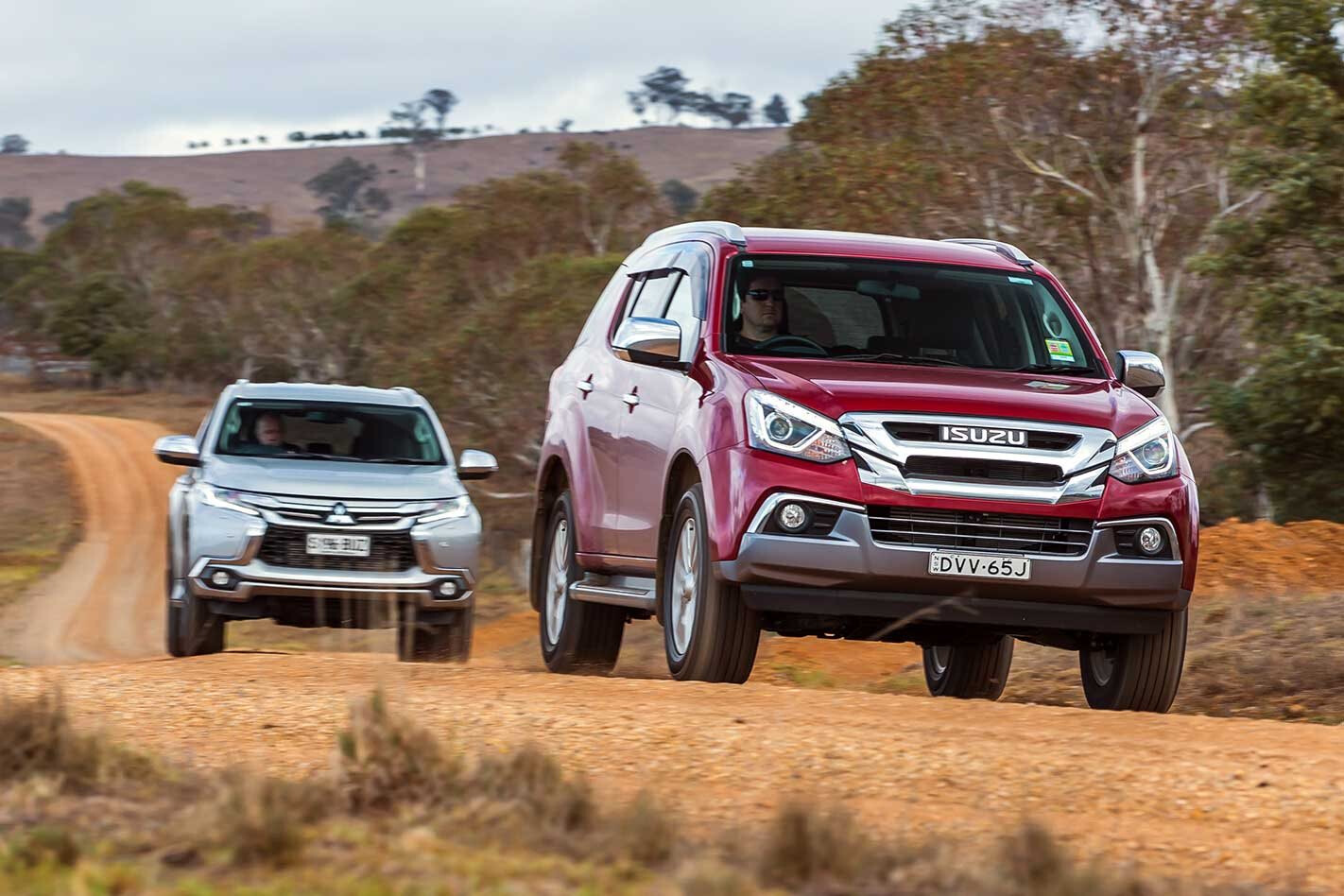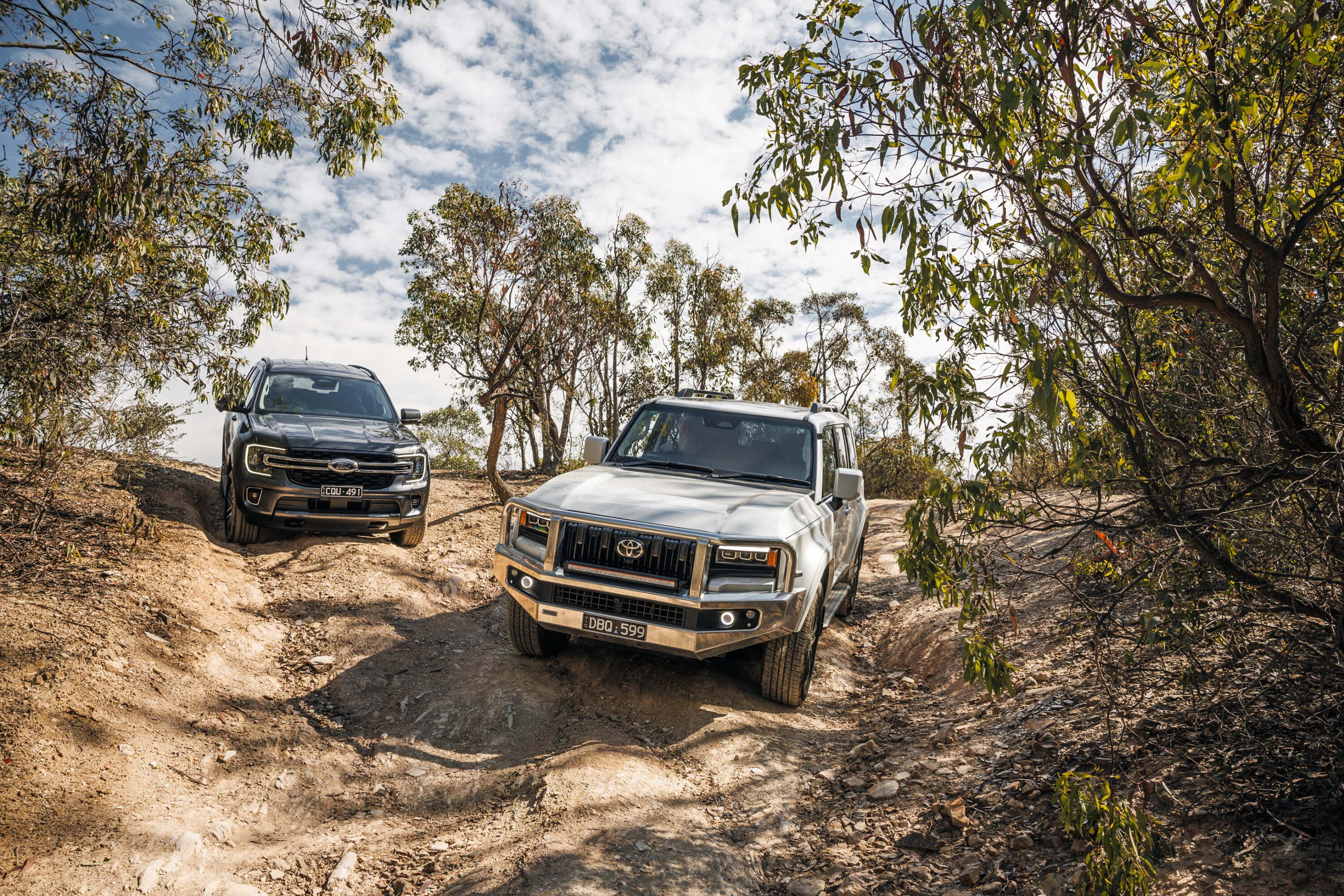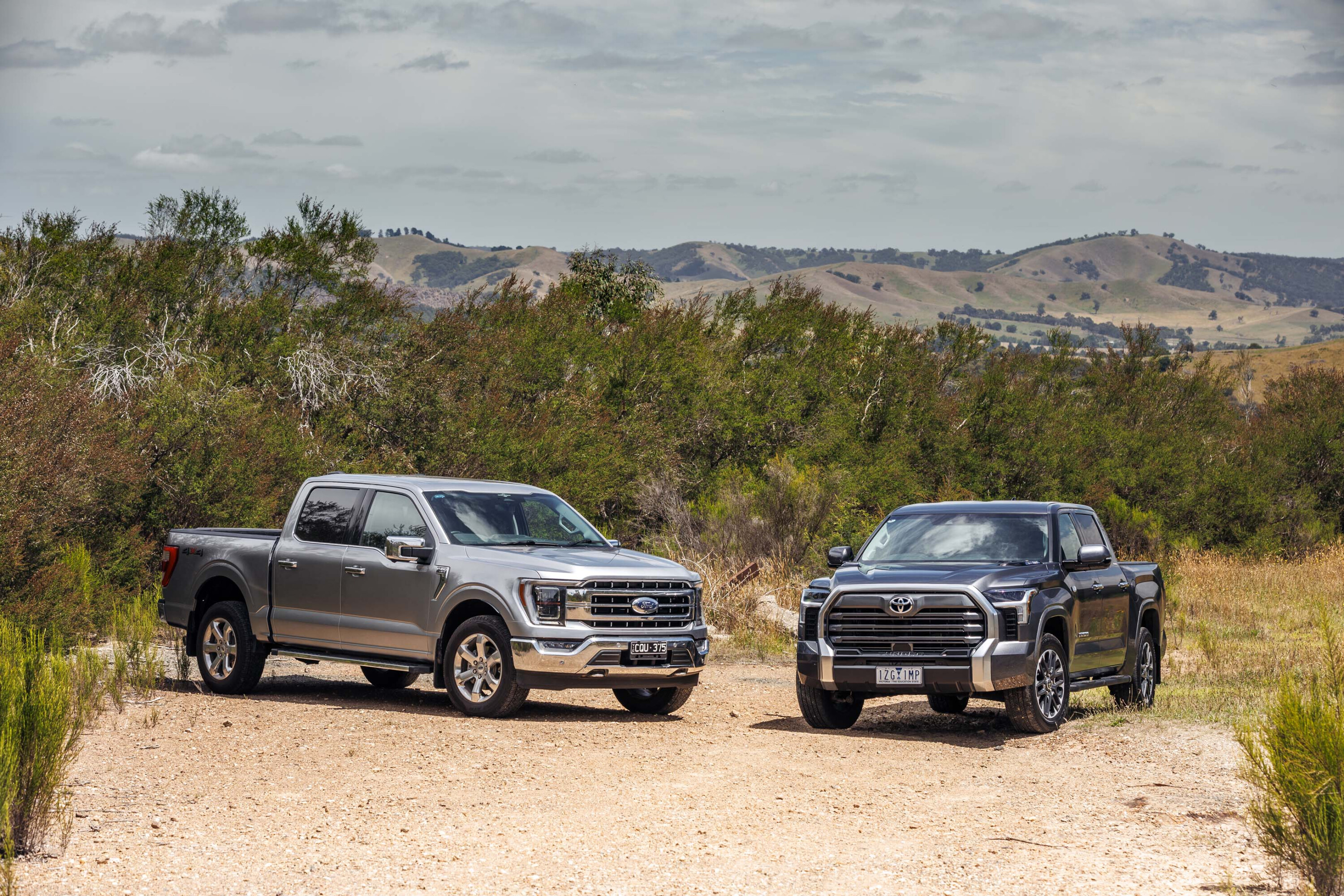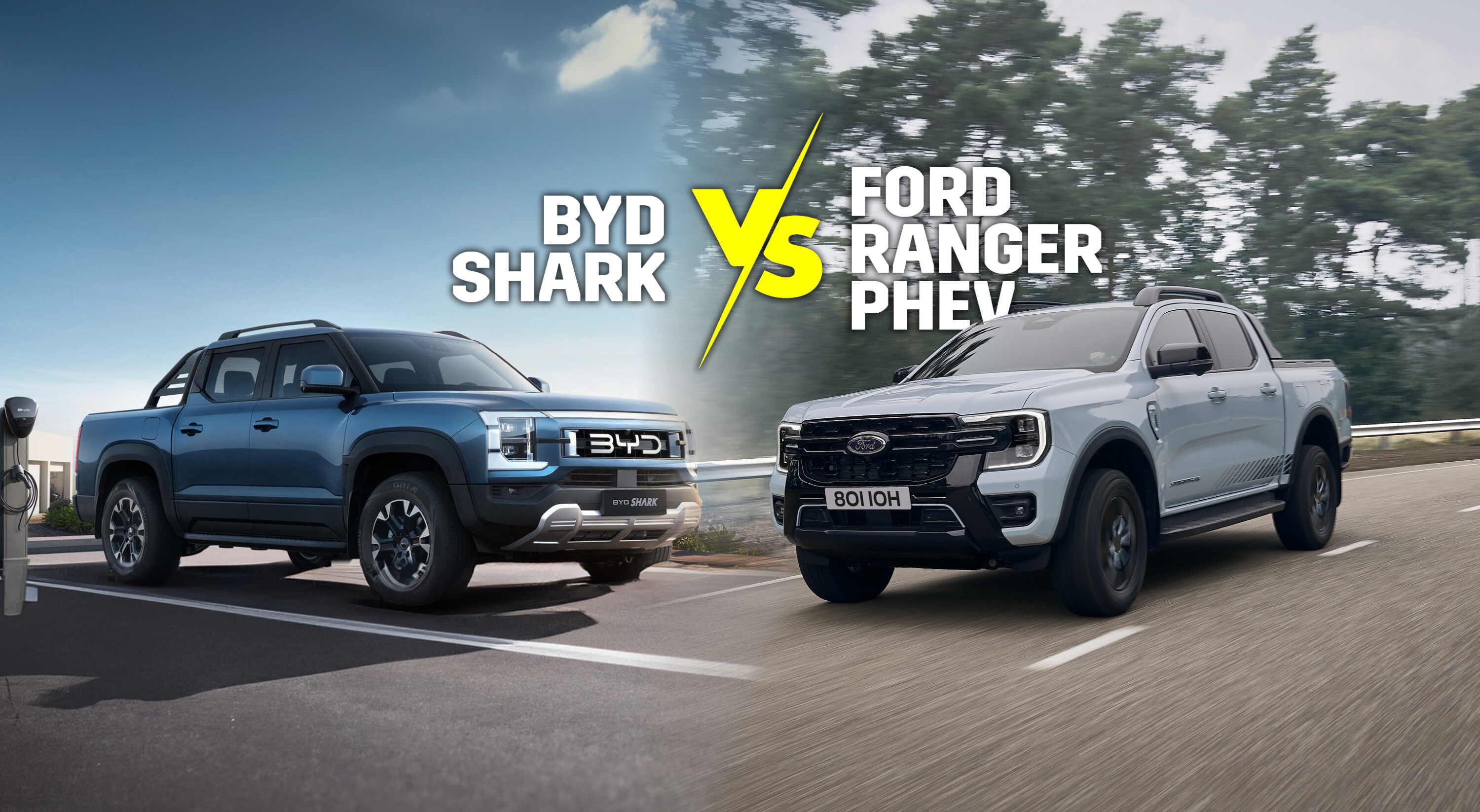It’s a way for manufacturers to get more sales volume without having to design a new vehicle from the ground up, and it is a process that’s led to the Ford Everest being developed from the Ranger, Toyota Fortuner from the Hilux, Holden Trailblazer from the Colorado, Isuzu MU-X from the D-MAX, and the Mitsubishi Pajero Sport from the Triton.
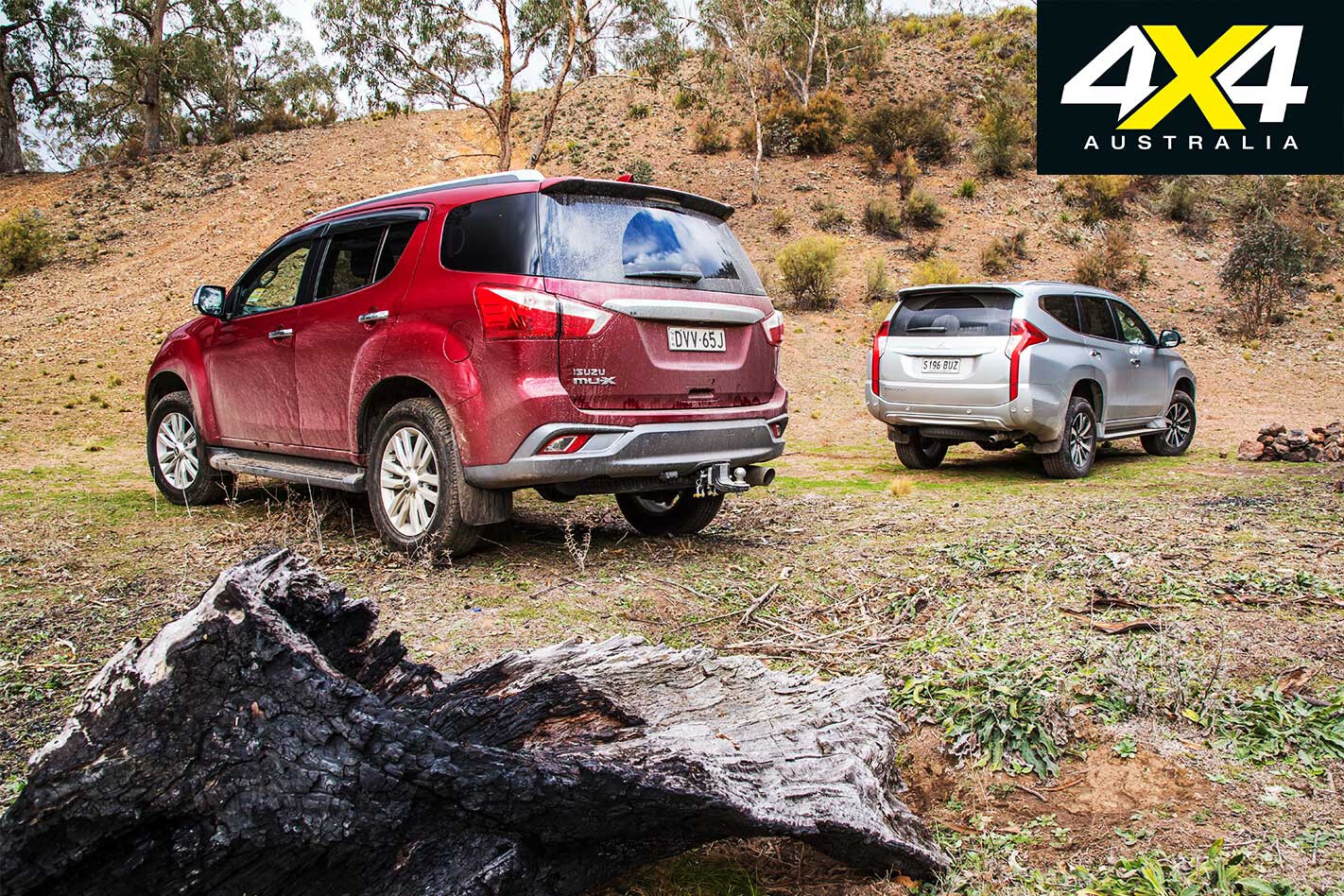
The build process is much the same: remove the ute body, shorten the wheelbase, swap the rear leaf springs for coils and the rear drum brakes for discs, and drop on the new wagon body.
In most cases the drivetrain remains untouched, save for the Everest gaining full-time 4×4 and the Pajero Sport an eight-speed automatic gearbox. It’s not only the manufacturer that wins here, as the relatively simple and robust design that is at the core of any ute lends itself well to an off-road vehicle, given robustness and simplicity are two desirable attributes of a 4×4.
Of these five wagons made from utes, the MU-X and the Pajero Sport are currently the best sellers and both have received a number of upgrades – most recently for the 2018 model year – since we tested them two years back, so it’s time to line them up again.
Isuzu MU-X – People’s Choice

ISUZU has been building MU wagons based on utes since 1989, the first introduced in Australia in 1995 as the largely forgotten Holden Frontera.
This generation MU-X (effectively a fourth-generation wagon-from-ute model for Isuzu) arrived in Australia in late 2013 and remained largely unchanged for three years. In the early 2017 upgrade it gained a significantly updated engine (primarily to meet mandatory Euro 5 emission requirements), new six-speed automatic and manual gearboxes, NVH enhancements and additional equipment
A few months later the MY17 arrived with refreshed front-end styling, new dash, more NVH control measures and additional equipment. From there the MY18 MU-X gained trailer-sway control. This three-stage evolution has produced an MU-X that’s vastly different to what arrived in 2013.
POWERTRAIN AND PERFORMANCE
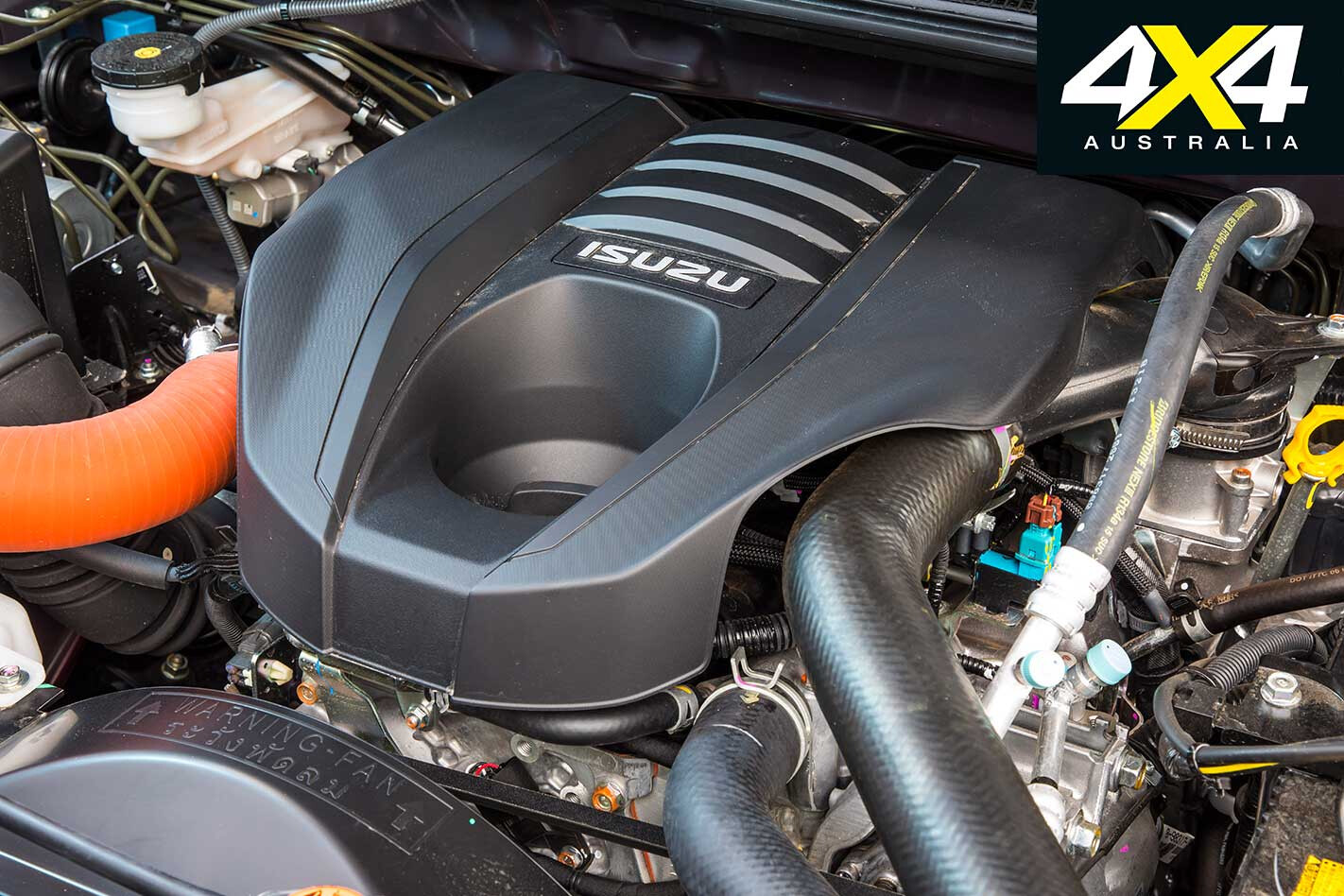
THE MU-X’s 3.0-litre four-cylinder diesel is the latest iteration of an engine that effectively dates back to 2005; the most recent upgrade has seen a raft of changes to comply with Euro 5 emission standards. Most notably it features a new variable-geometry turbocharger, higher pressure common rail injection, revised pistons and a diesel particulate filter.
While Isuzu had no choice in making the engine Euro 5 compliant, the good news is there’s more torque available over a wider rpm range. However, the max power remains at 130kW, so while the engine is now far more flexible in general driving, pedal-to-the-metal performance is much the same.
The upgrade from the five-speed auto to a six-speed auto doesn’t help performance, either, as it adds an extra (and very tall) overdrive ratio rather than tightening up the ratio spread, so it’s more a change in the interests of fuel efficiency. The gearbox is an Aisin design and essentially the same as the six-speed auto used in Toyota’s Hilux, Prado and Fortuner.
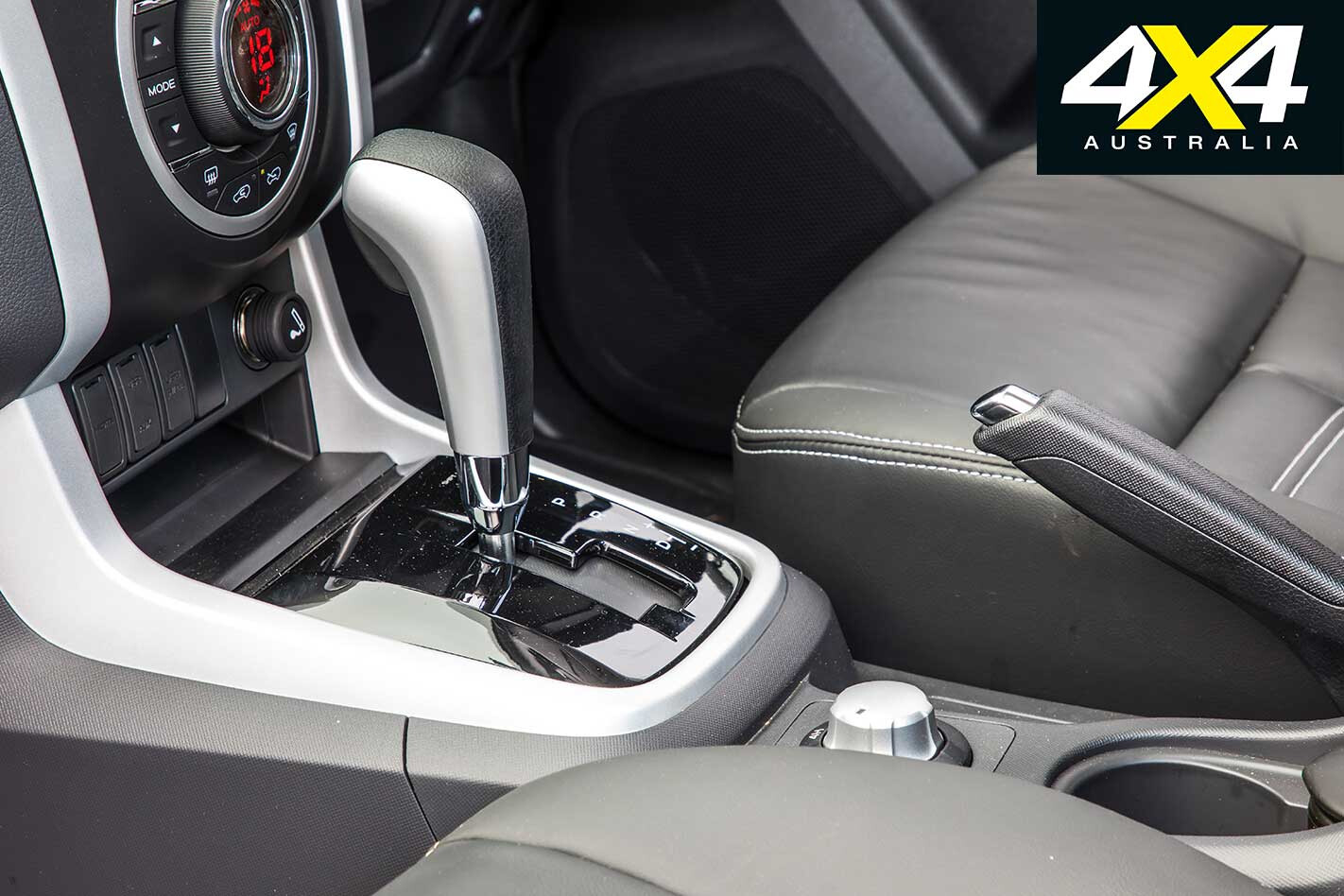
On the road the engine is relatively low revving, effortless and relaxed in general driving, but not notably strong when asked to give its all. Nor is it as responsive as the smaller engine in the Pajero Sport, which makes similar maximum power and torque numbers but benefits from lower overall gearing and its relatively close-ratio eight-speed gearbox. It’s also not as quiet or smooth as the smaller and lower-compression engine in the Pajero Sport.
For its part the MU-X’s six-speed automatic offers reasonably smooth and well-timed shifts and is far more proactive in its shift protocols than the five-speeder used previously; although, the extra-tall fifth and sixth ratios mean some shuffling back and forth between the two at highway speeds on undulating roads.
HANDLING AND RIDE
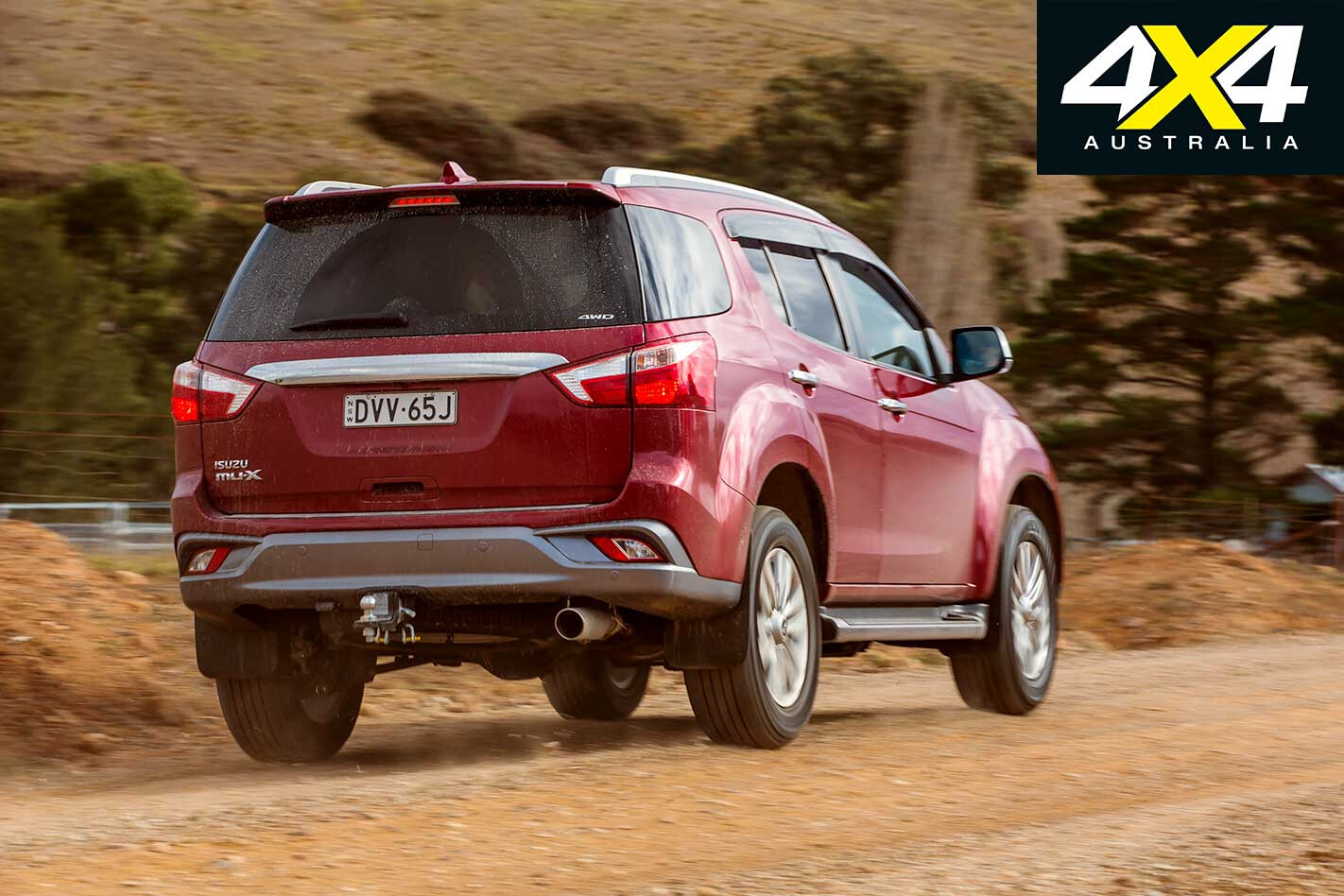
ISUZU has always managed to do a good job with suspension calibration for Australian conditions, and this latest iteration of the MU-X is no exception. The ride quality is compliant and comfortable, yet the bodyroll isn’t excessive and the overall suspension control is good. Road noise isolation is also better than it was with the earlier MU-X.
However, on bumpier roads at higher speeds you feel the live axle’s tendency to create some bump-steer. The notably light steering could also do with a bit more feel, while the MU-X also lacks the advantage of the Pajero Sport’s full-time 4×4. Compared to the Pajero Sport the MU-X feels bigger (which it is) and not as nimble or agile.
OFF-ROAD
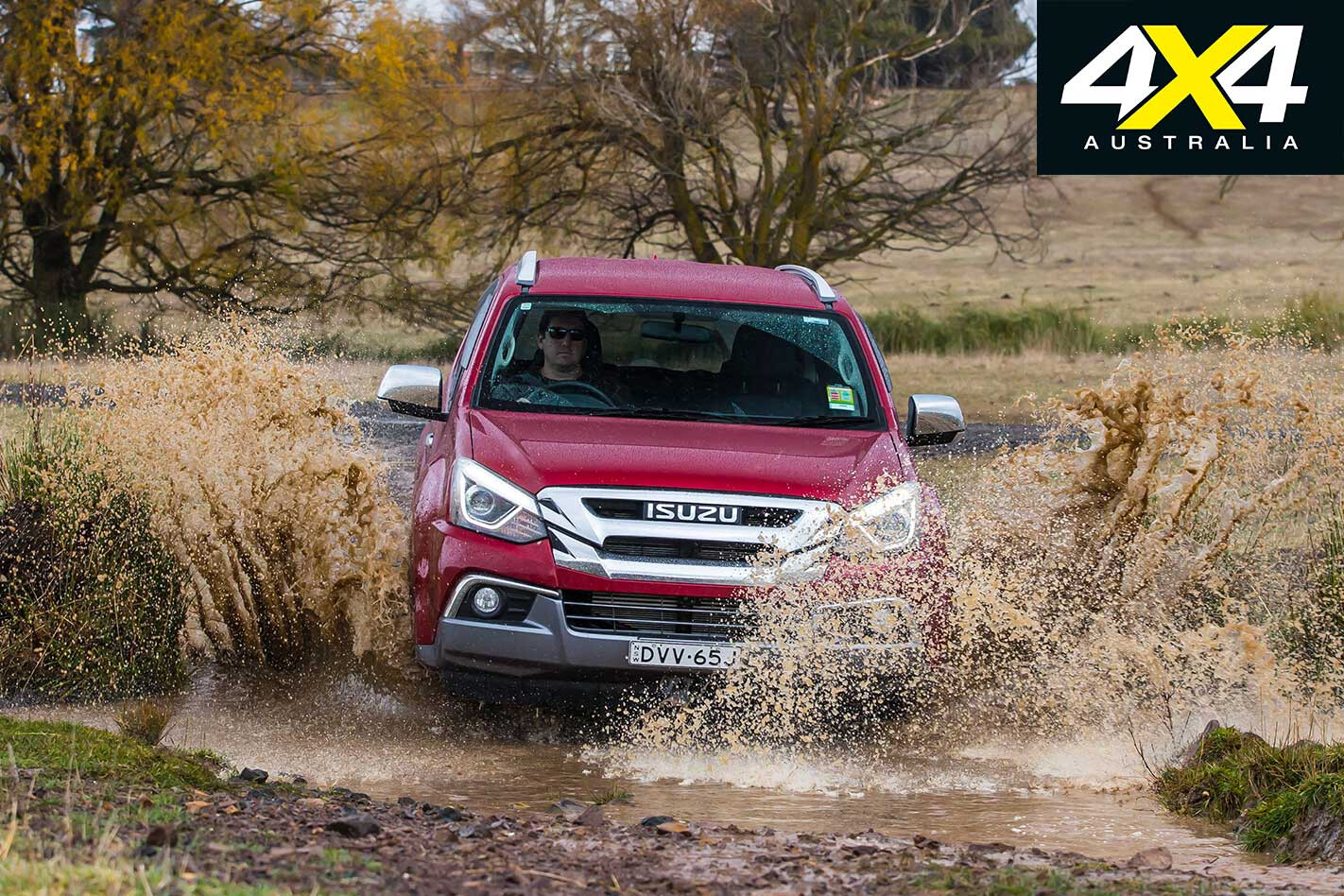
THE MU-X has decent clearance, a good driving position and it’s very well protected underneath; although, as with most current 4x4s, the light-duty side-steps are vulnerable. In gnarly conditions the MU-X’s modest wheel travel puts more emphasis on the performance of the electronic traction control, which unfortunately could be better.
The MU-X is still a very capable tourer, but in tough off-road conditions that wouldn’t faze an Everest or Fortuner it will struggle and could do with off-road specific calibration of its ETC – as Holden has done with the MU-X’s cousin the Trailblazer – to improve its hardcore ability.
In most other ways the MU-X ticks the off-road boxes: the part-time 4×4 system is straightforward to operate (via a rotary dial), it has a practical wheel and tyre spec and the ability to fit wheels down in size to 16-inch, and it draws its engine intake air from the inner ’guard for peace of mind when crossing deep water.
WHAT YOU GET
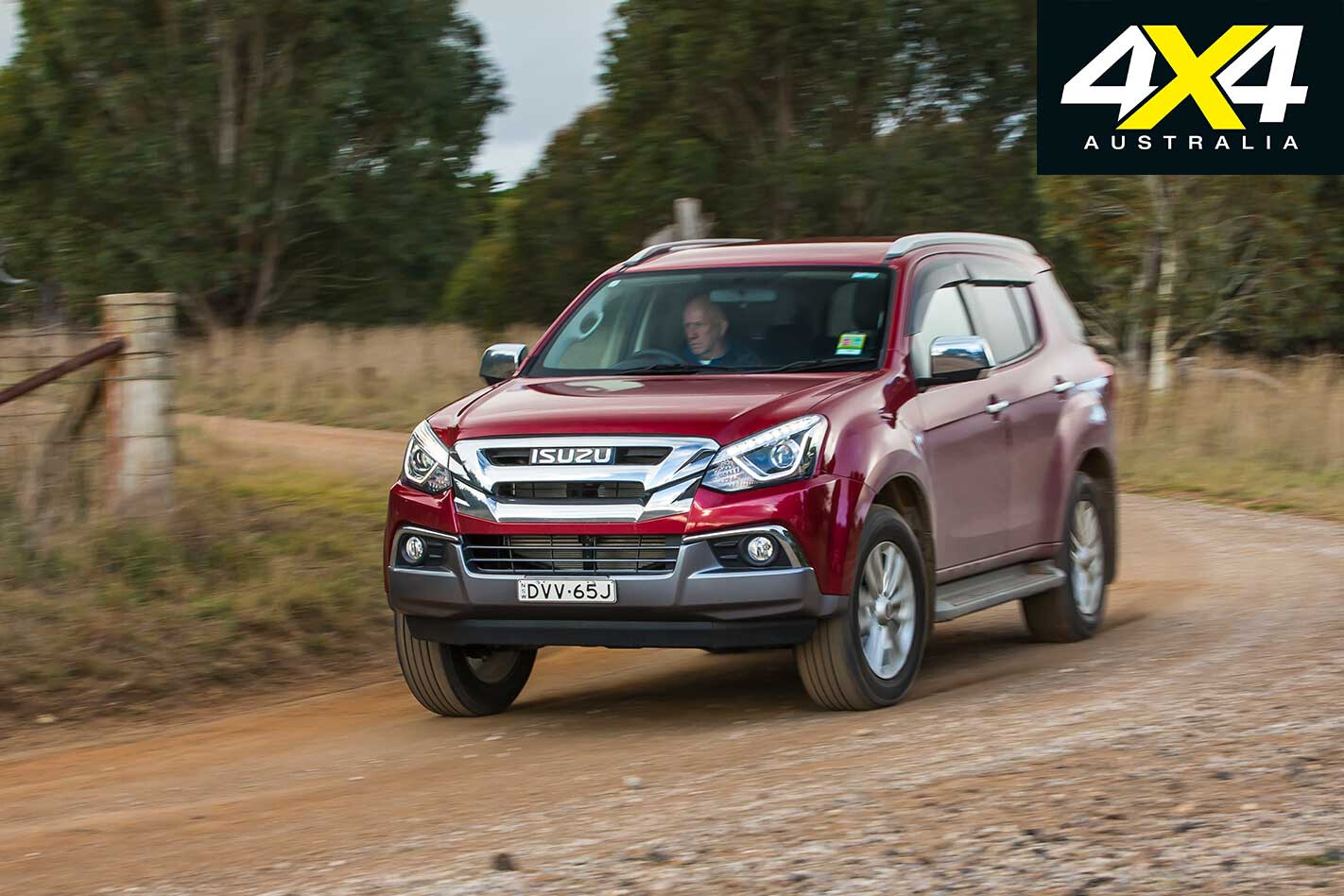
THE base-spec LS-M comes with an automatic gearbox and standard features including six airbags, 7-inch touchscreen, Bluetooth, USB input, reversing camera, LED DRLs and headlights, and trailer-sway control.
The LS-U adds an 8-inch touchscreen, sat-nav, climate control, air-con outlets for rear passengers, fog lights, side-steps, rear privacy glass, 18s in place of the LS-M’s 16s, and a six-speed manual is available. The auto-only LS-T then adds ‘smart-key’ entry and start, leather seats with electric-adjust for the driver, a rear DVD entertainment system with a 10-inch roof-mounted screen, roof rails, and a tailgate spoiler.
CABIN AND SAFETY
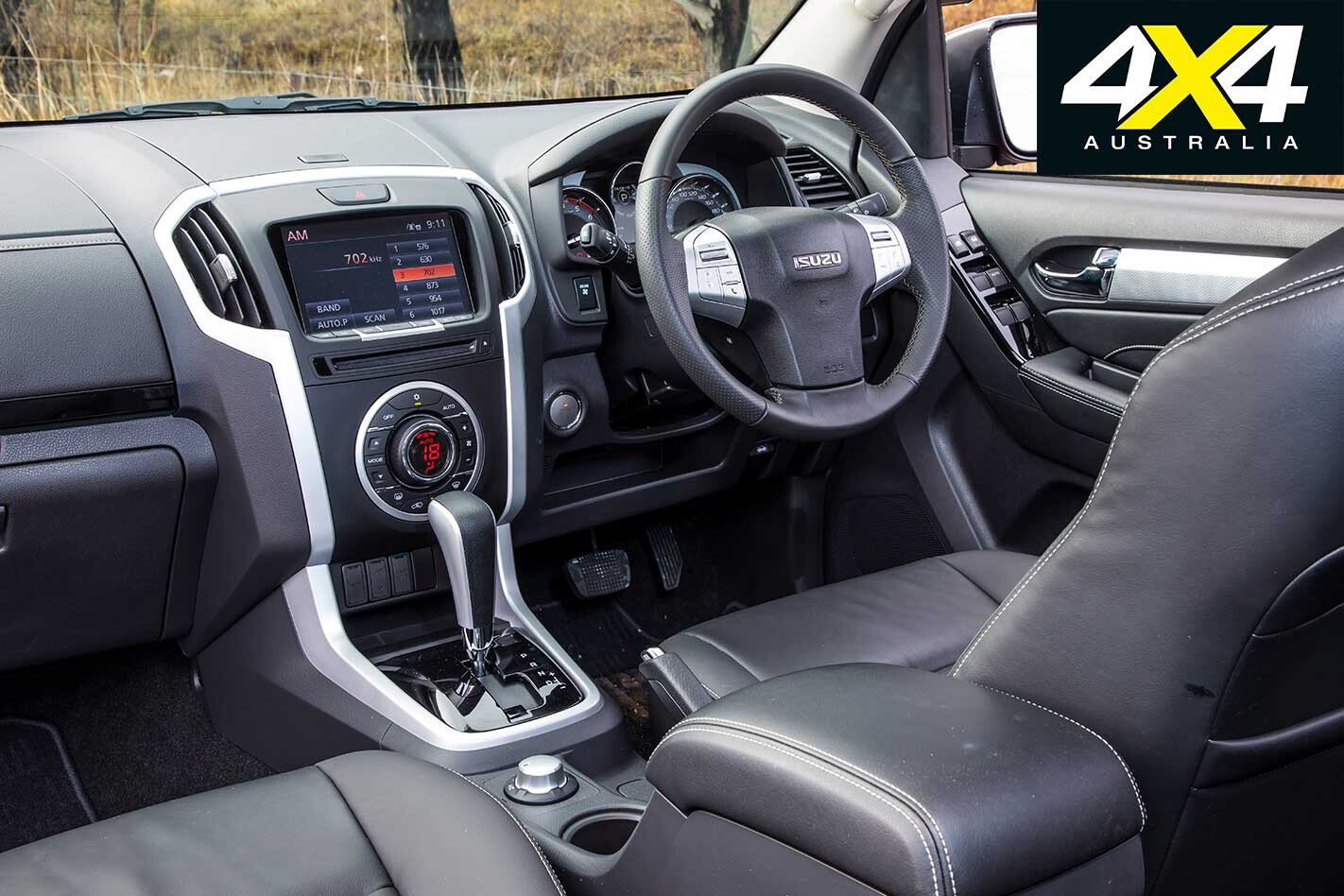
SMART-KEY entry (on this top-spec LS-T) and conveniently placed grab handles make it easy to climb aboard to the comfortable and spacious driving position. The MU-X’s fit and finish and general presentation is much better than before, and it has certainly lost the ‘cheap’ feel that let down the earlier models. There’s no reach adjustment for the steering wheel, though.
The back seat is a bit of a squeeze for three adults (two adults and a child is more ideal) but is more spacious than the Pajero Sport. The third-row seats are easy to deploy and can seat adults in reasonable comfort, but they come at the cost of reduced luggage space with the high floor they create.
Thanks in part to six airbags the MU-X offers five-star ANCAP safety, but it doesn’t come with any high-end safety features.
PRACTICALITIES

THE MU-X offers a five-year warranty, five-year roadside assistance and a five-year/75,000km fixed price servicing (every 15,000km or 12 months), all through some 120 Isuzu dealers nationwide.
Factory accessories include steel and aluminium-alloy bullbars and a snorkel, while the MU-X is increasingly well served by the 4×4 aftermarket. The MU-X’s tow rating of 3000kg and payload of around 600kg are typical in this class.
WHAT’S IN A NAME?
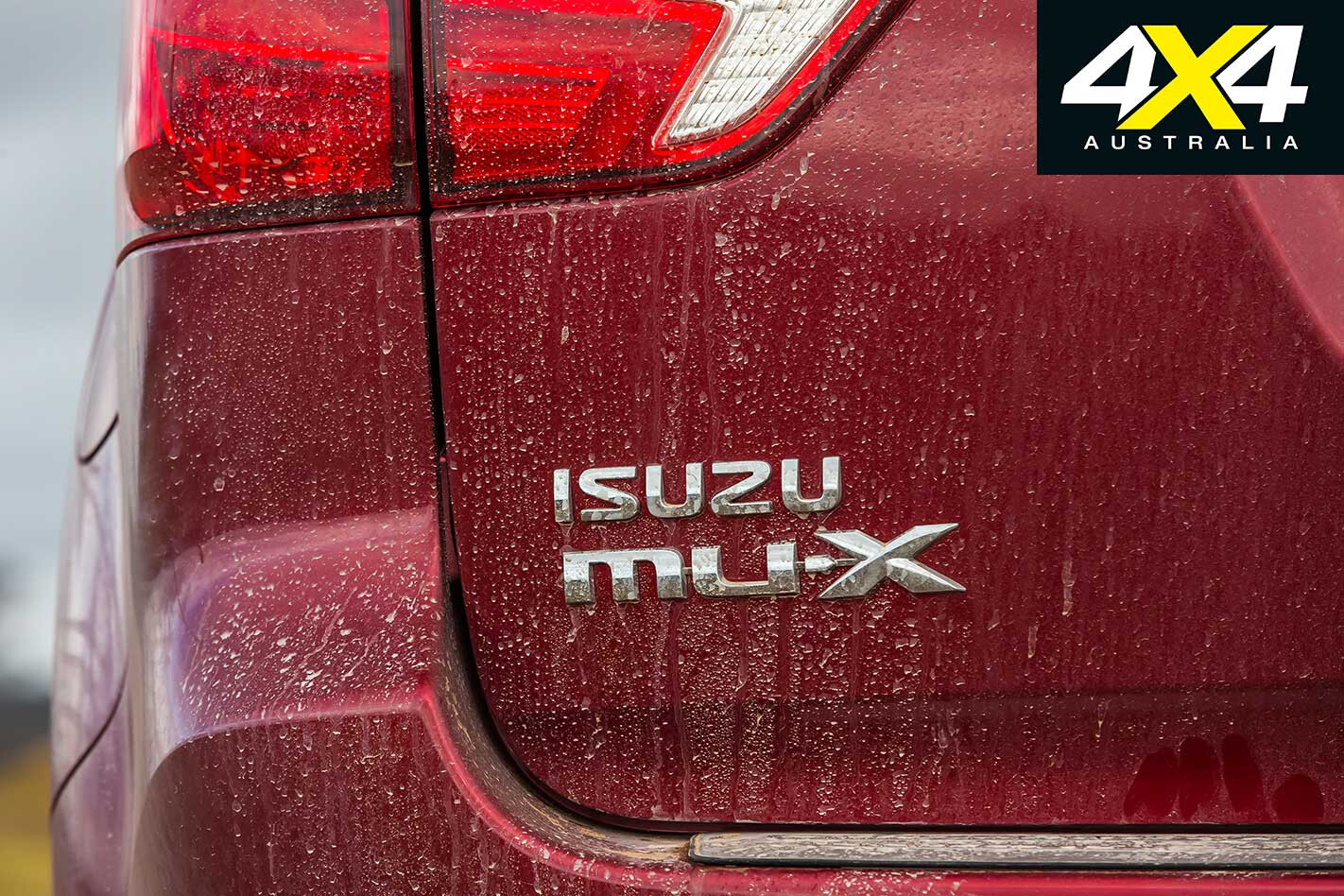
ISUZU Ute Australia only started selling the D-MAX and MU-X here in 2008, but Isuzu vehicles have been around much longer than that in Australia, with most of them sold wearing Holden badges.
These include the Gemini small car, every Rodeo ute (as well as the first Colorado), the Jackaroo 4×4 wagon and the Holden Frontera, which was sold elsewhere as the Isuzu MU and was the predecessor of the MU-X. In Isuzu-speak, MU originally stood for ‘Mysterious Utility’.
Mitsubishi Pajero Sport – Challenger Mark III?
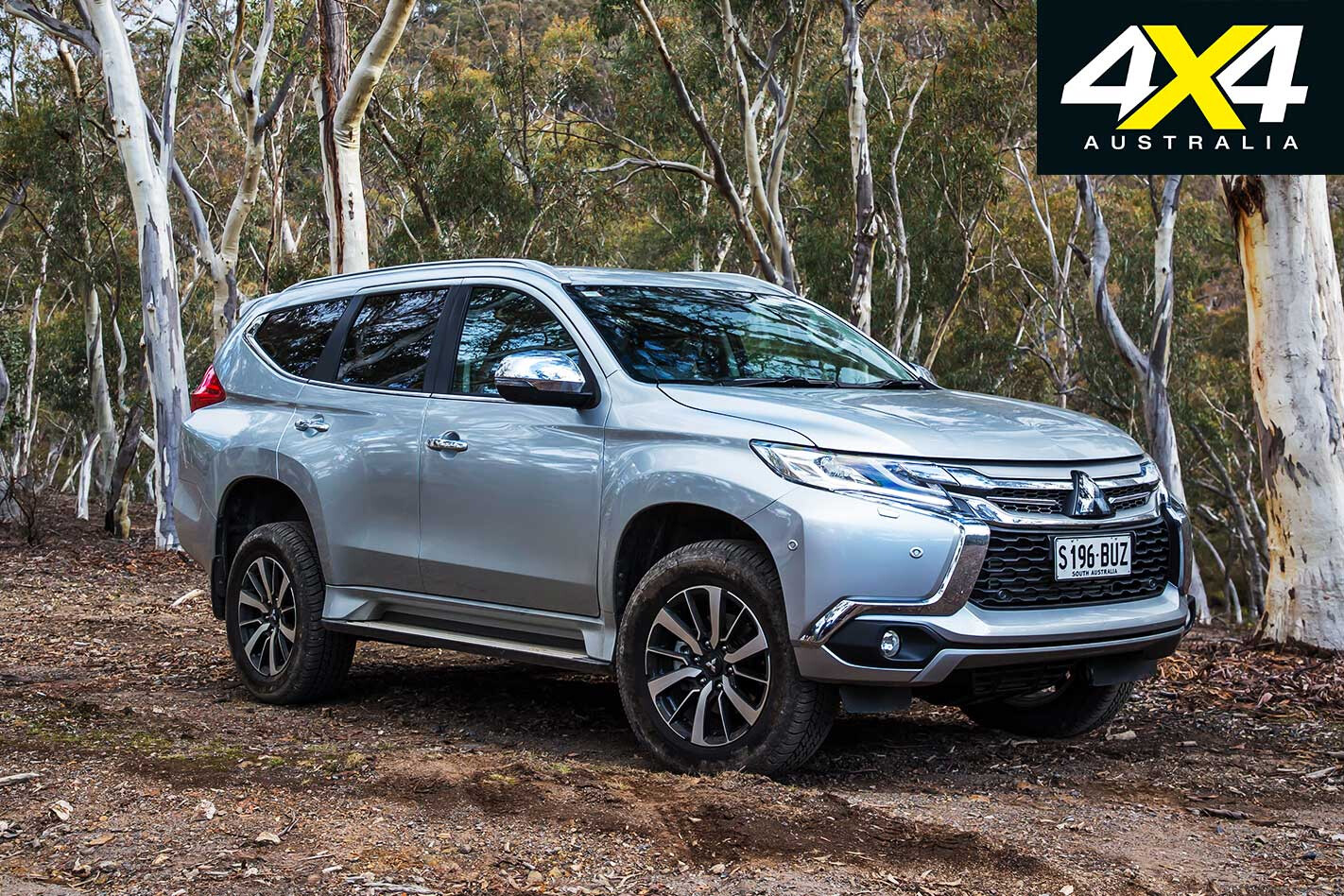
MITSUBISHI has being building a wagon based on the Triton ute since 1996, and in some parts of the world it was called a Pajero Sport right from the get-go. In Australia, however, it was called the Challenger through the first two generations, with the Pajero Sport name only adopted here for this latest model that arrived in late 2015 off the back of the then new-generation Triton.
Despite its name the Pajero Sport has little to do with the current Pajero and, in fact, any Pajero for nearly 20 years, as the Pajero is a monocoque with fully independent suspension whereas the Sport has an old-school separate chassis and live rear axle.
When it arrived in 2015 the Pajero Sport was only available as a five-seater, but third-row seats were introduced on mid- and top-spec models in mid-2016. The Pajero Sport’s latest update has seen automatic emergency braking and radar cruise control, features previously exclusive to the top-spec Exceed model, become standard across the range.
POWERTRAIN AND PERFORMANCE
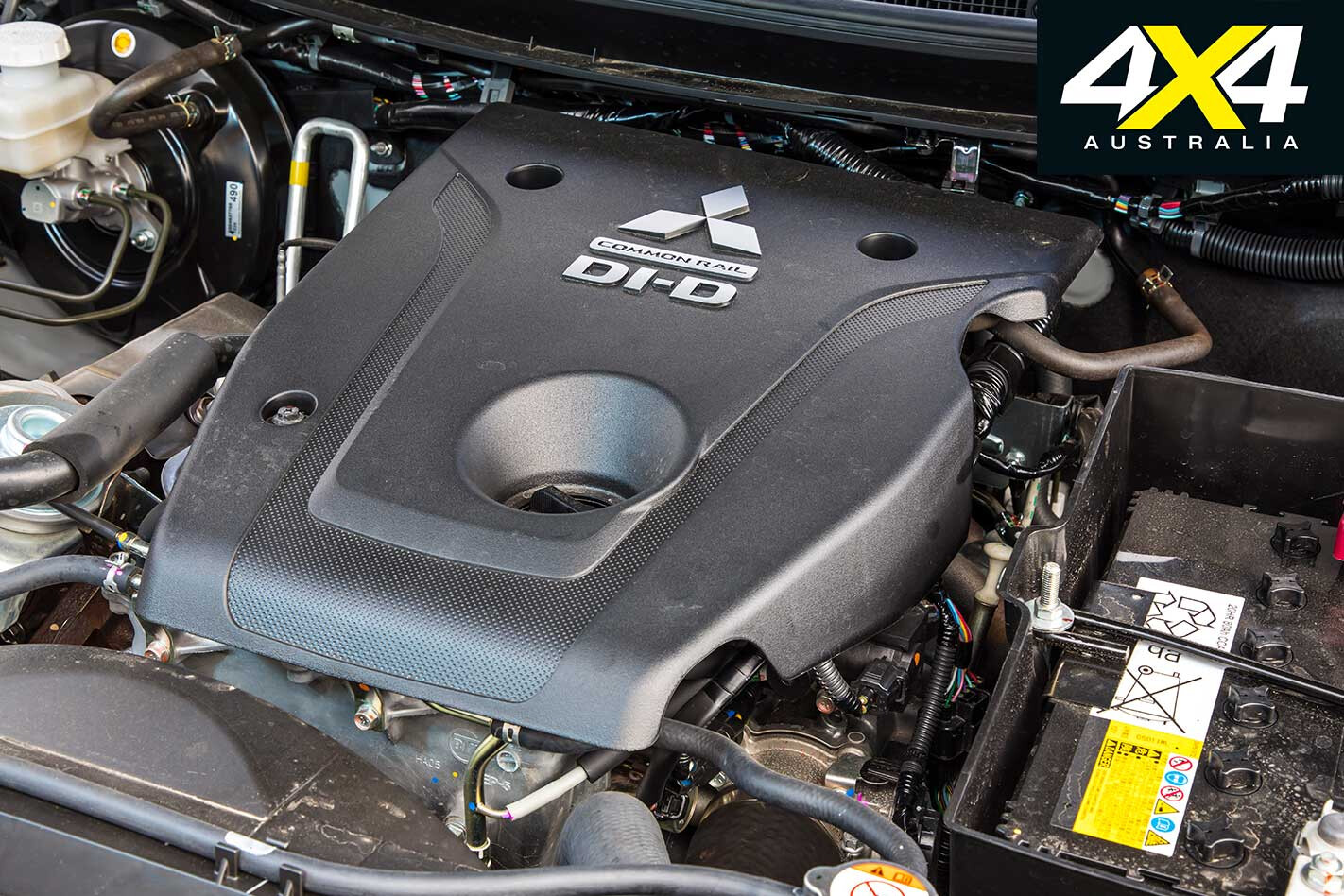
THE Pajero Sport shares the same 2.4-litre four-cylinder diesel as the Triton, an all-new engine in 2015. It boasts Euro 5 compliance and claims more power and torque than the older 2.5-litre diesel used in the Challenger and the previous generation Triton.
The 2.4 is a modern all-aluminium design with variable valve timing, a relatively low compression ratio (for refinement and lower NOx), high-pressure common rail injection and a low inertia variable geometry turbocharger. Surprisingly for a relatively small capacity four it also employs counter-rotating balance shafts for improved smoothness.
On the road the engine delivers on this promise of modernity and is quiet, smooth and refined. Despite its smaller capacity it claims the same maximum torque (430Nm) as the 3.0-litre in the MU-X but needs 500rpm more to get there; not achieving its maximum torque until 2500rpm, an unusually high figure for a modern diesel.
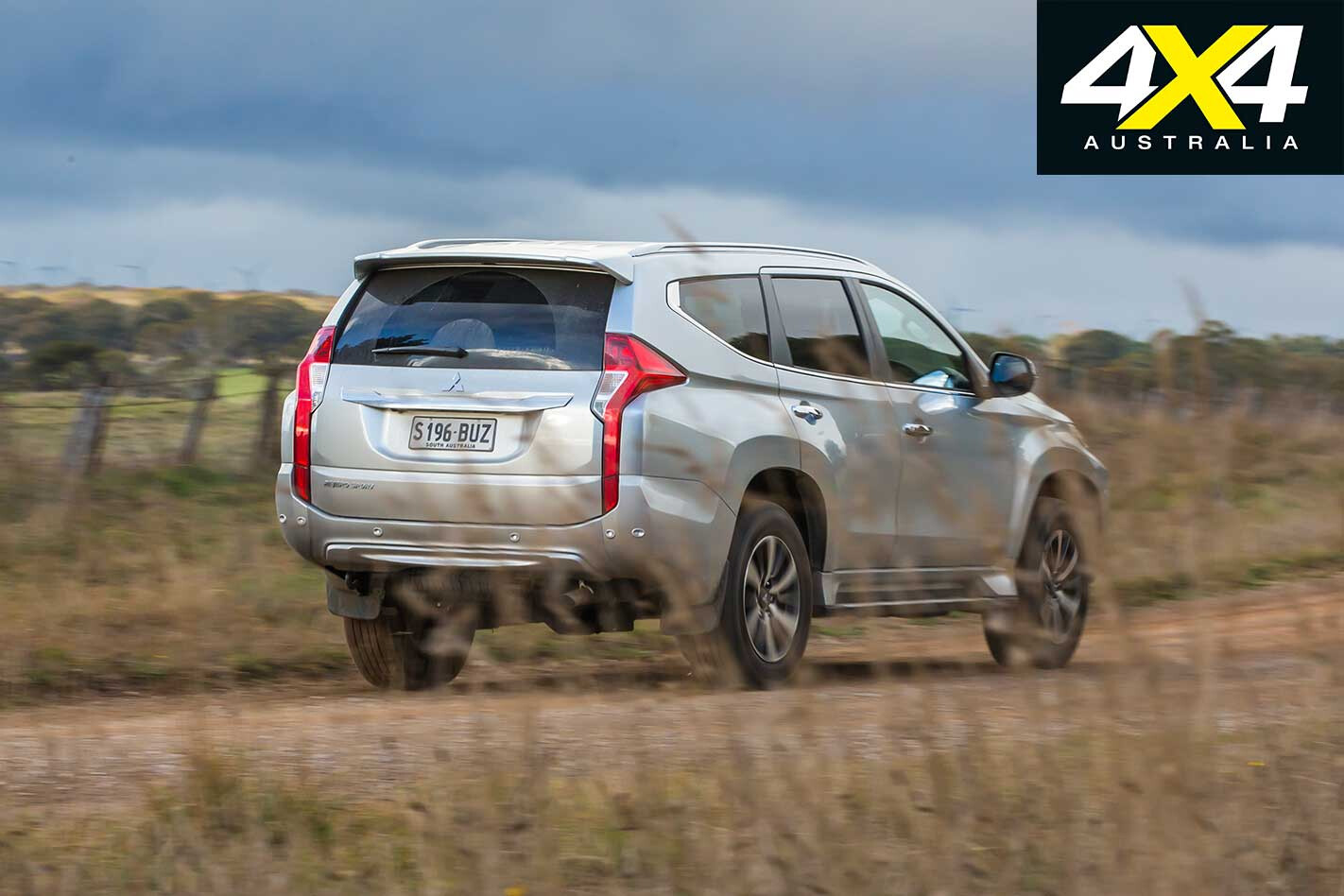
Surprisingly, however, it reaches its slightly stronger (133kW vs 130kW) maximum power figure at slightly lower revs (3500rpm vs 3600rpm) than the notably bigger engine in the MU-X. Given the similarity in the power and torque claims you would expect the two to offer similar get-up-and-go, but the Pajero Sport benefits from lower overall gearing and a tighter ratio spread from its eight-speed automatic. It’s also more responsive in give-and-take driving.
Unlike all other wagons made from utes the Pajero Sport doesn’t share the gearbox of its donor ute, in this case the Triton’s five-speed automatic. This is a good thing, as the eight-speed is a notably slicker and smoother shifting gearbox than the Triton’s now dated five-speeder.
The refinement of the Pajero Sport’s eight-speed auto also compliments the refinement of its engine, giving the powertrain a general feeling of sophistication the MU-X lacks.
HANDLING AND RIDE
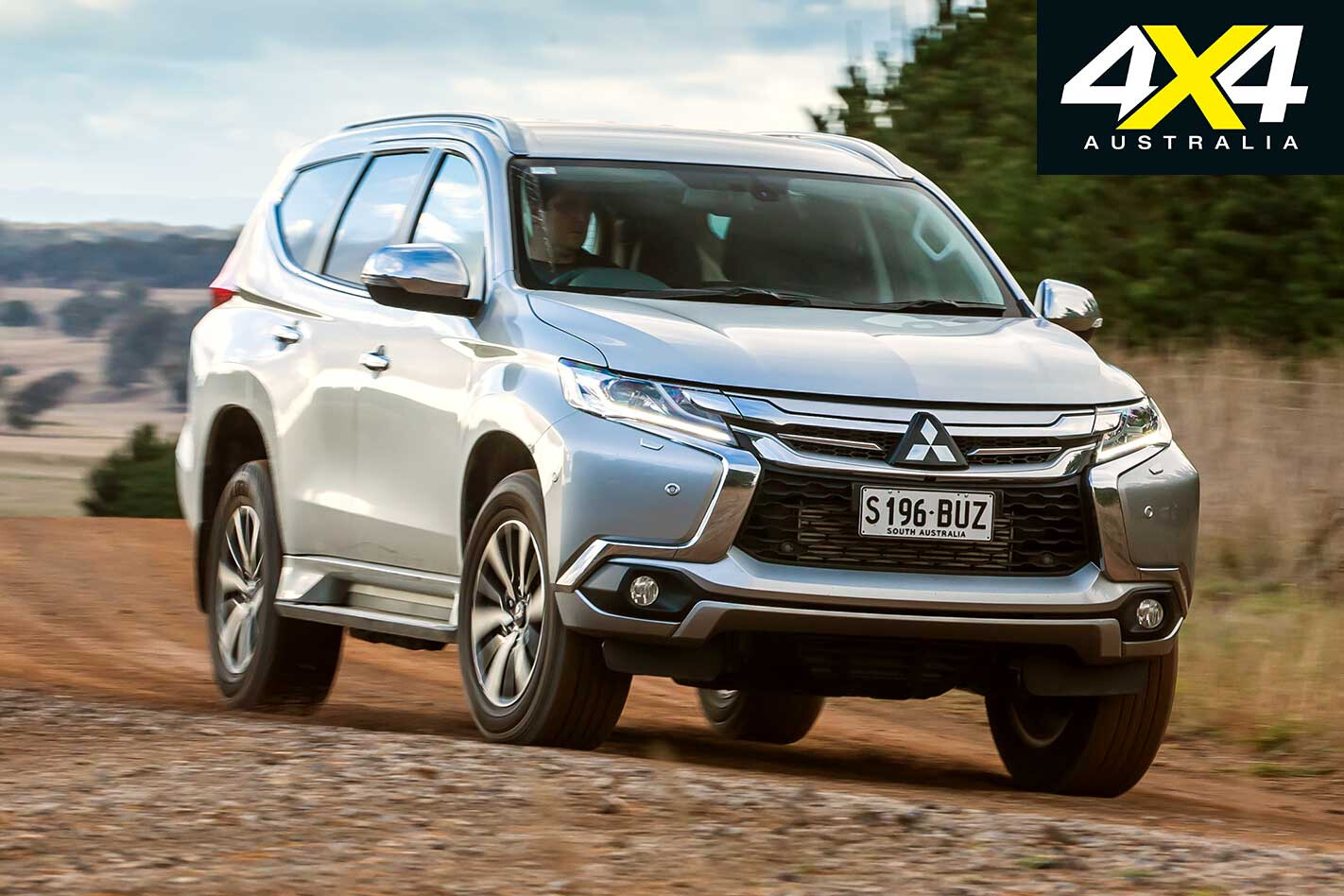
THE Pajero Sport’s full-time 4×4 is also more sophisticated, offering more confidence and grip on any wet or loose road surface, as well as the convenience of being able to drive on a variety of wet or dry, sealed or unsealed roads without having to think about whether to shift into ‘high four’ – as you need to do with a part-time 4×4 system like that of the MU-X.
The Pajero Sport feels smaller than the MU-X (namely because it is) and generally more agile in the way it handles and steers. A more connected steering feel than the MU-X also helps in making it a more sporting drive.
OFF-ROAD
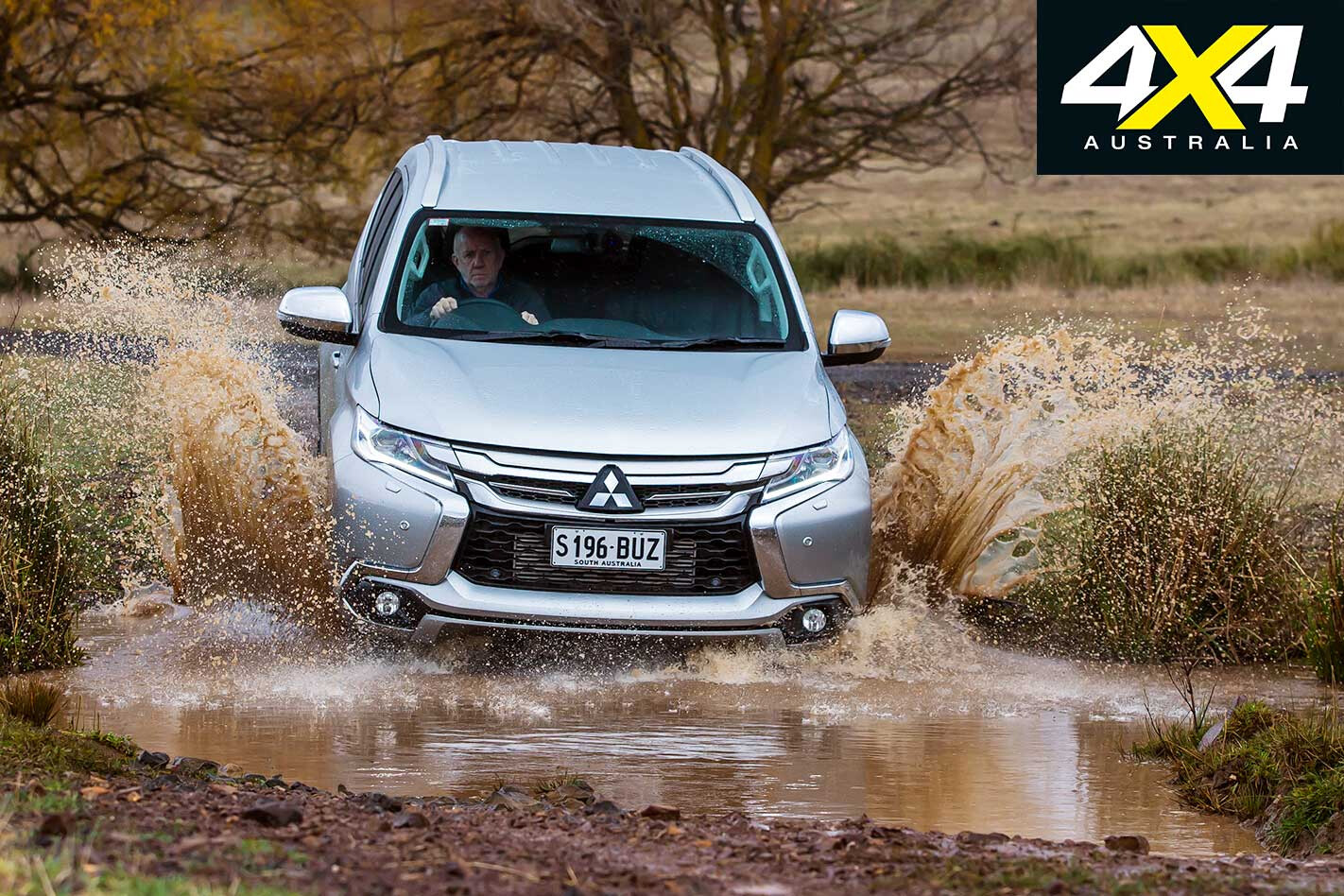
LIKE the MU-X, the Pajero Sport’s wheel travel, an all-important off-road attribute, is more modest than good; likewise the calibration of the electronic traction control, which could be more effective in difficult off-road conditions.
The Pajero Sport does, however, have a driver-switched rear diff lock, but the trouble is engaging the locker cancels the electronic traction control on both axles, so it’s not always beneficial.
The end result is off-road performance generally on a par with the MU-X; although, the Pajero Sport is a bit more manoeuvrable and handy in tight spots and has less front overhang. In a notable and most welcome departure from the Triton, the Pajero Sport’s engine air intake is via the inner mudguard rather than under the bonnet lip.
All Pajero Sport models come with 18s but will take 17s from the Triton, which opens up the options in terms of more off-road-orientated tyres than the standard items.
WHAT YOU GET
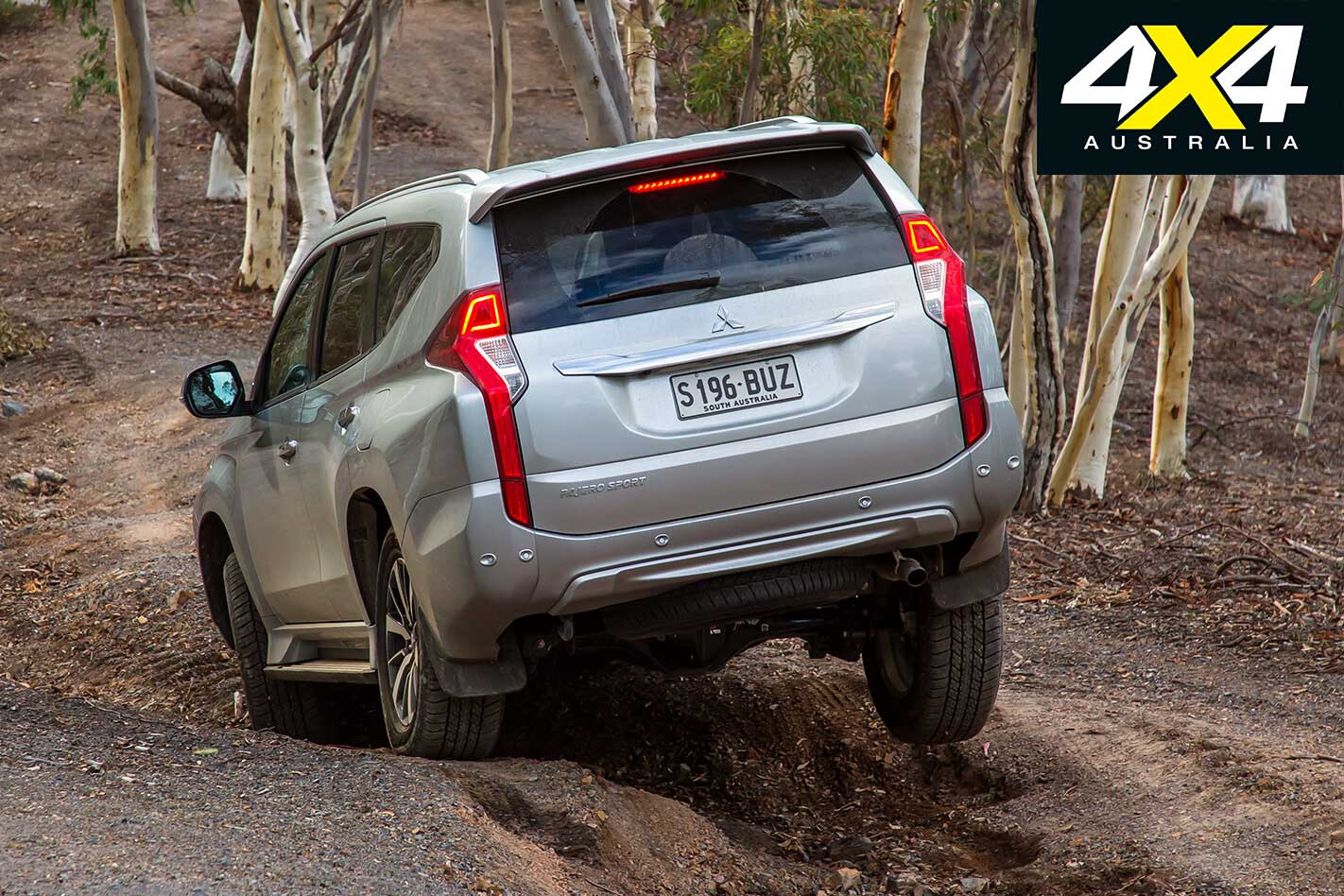
ALL Pajero Sport models have an eight-speed auto gearbox, 18-inch alloys, LED headlamps and DRLs, tilt and reach steering wheel adjustment, Smart entry and start, digital radio, hill-descent control, selectable ‘Off-Road’ mode, rear parking sensors, reversing camera, trailer sway control, automatic emergency braking and adaptive cruise control.
Over the GLX, the GLS has the option of seven seats, dual-zone climate, leather, electric seat adjust for driver and passenger, six speakers, auto headlights and wipers, and a rear locker. The top-spec Exceed adds heated front seats, headlight washers, two additional audio speakers, blindspot monitoring and a tailgate spoiler.
CABIN AND SAFETY
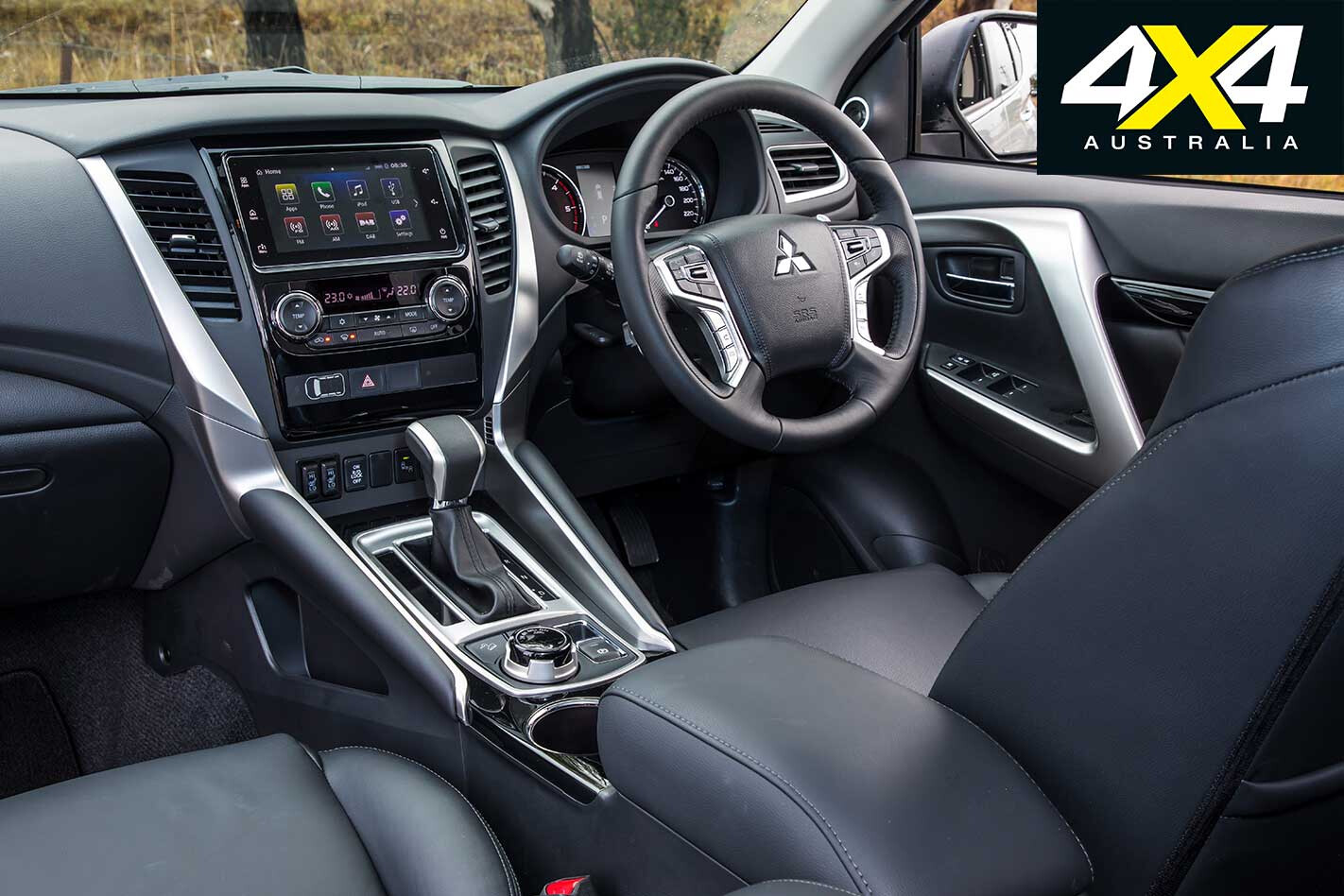
THE Pajero Sport’s cabin is noticeably smaller than the MU-X, something you notice in all three rows of seats. Thankfully Mitsubishi has addressed one problem with the driving position by adding soft trim on the side of the centre console, where previously the hard trim would press against the left leg of a tall driver. It does have tilt and reach steering wheel adjustment, though, something absent in the MU-X.
Put three adults across the rear seat of the Pajero Sport and you’ll also notice how much narrower the cabin is and that the third row isn’t adult-friendly as the MU-X’s.
Like the MU-X, the Sport has a five-star ANCAP safety rating. All models have automatic emergency braking and the Exceed gets blindspot monitoring, safety features not found on the MU-X.
SUPER SELECT
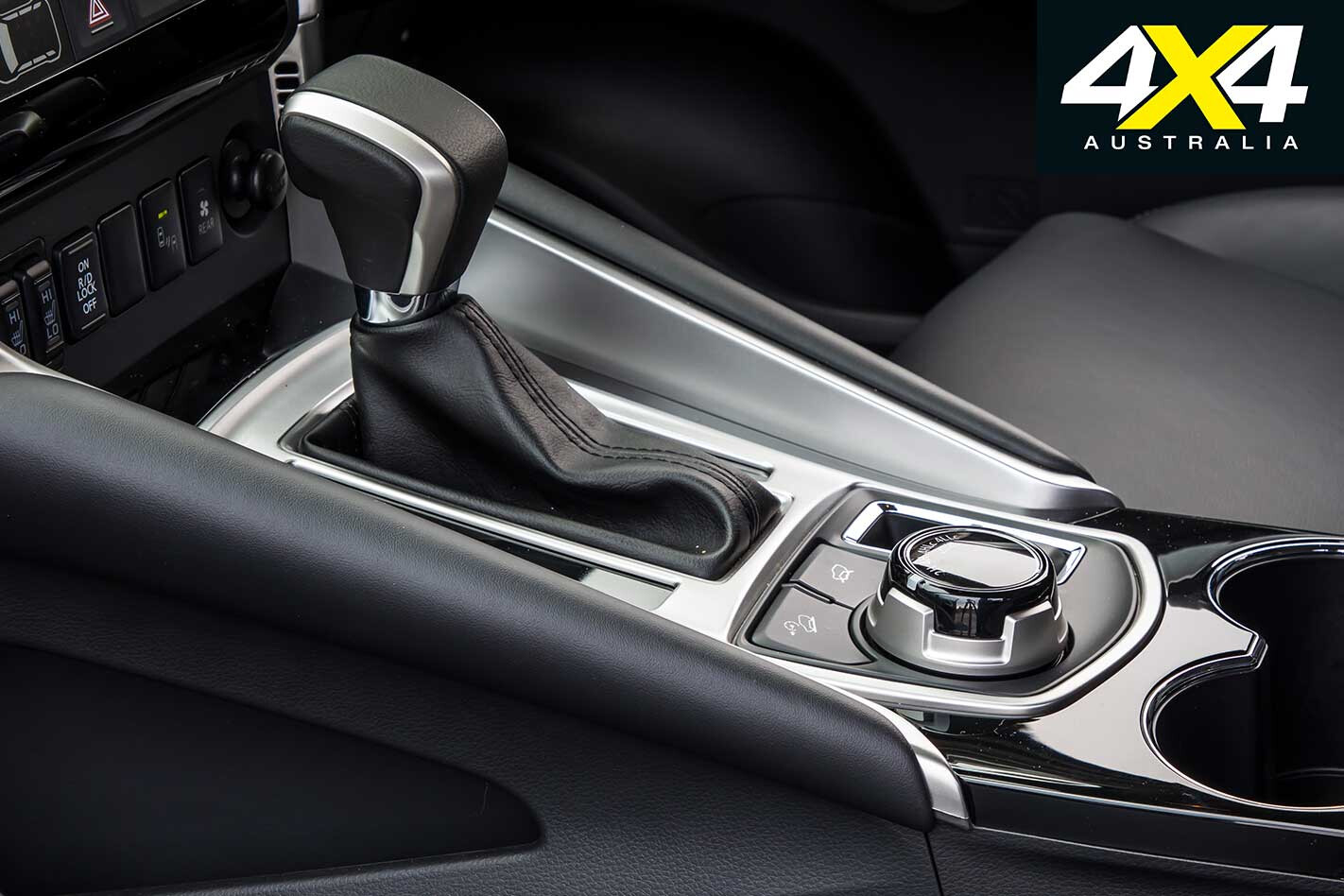
ALL Pajero Sport models feature Mitsubishi’s Super Select 4×4 system; also found on top-spec Tritons and the Pajero. In essence it combines full-time 4×4 and part-time 4×4 in one system in as much as the driver can select between rear-wheel drive and all-wheel drive on a high-traction surface such as dry bitumen.
The system is modelled on Jeep’s Selec-Trac system that debuted in 1983 on the Jeep Wagoneer. As with the Jeep system, Super Select allows the driver to select between rear-wheel drive, high-range four-wheel drive with the centre diff open, high-range four-wheel drive with the centre diff locked, and low-range four-wheel drive with the centre diff locked.
PRACTICALITIES

THE Pajero Sport offers a five-year warranty, four-year roadside assistance, three-year capped-price servicing and 15,000km/12-month service intervals.
The Pajero Sport has a smaller fuel tank than the MU-X (at 68 litres it’s the smallest in the class), which means the better part of 100km less touring range given both return similar fuel-consumption figures. However, the Pajero Sport has a nominally higher tow rating (3100kg vs 3000kg) and payload. Factory accessories include an aluminium bullbar and snorkel, with a broader range of 4×4 accessories available via the aftermarket.
The Verdict
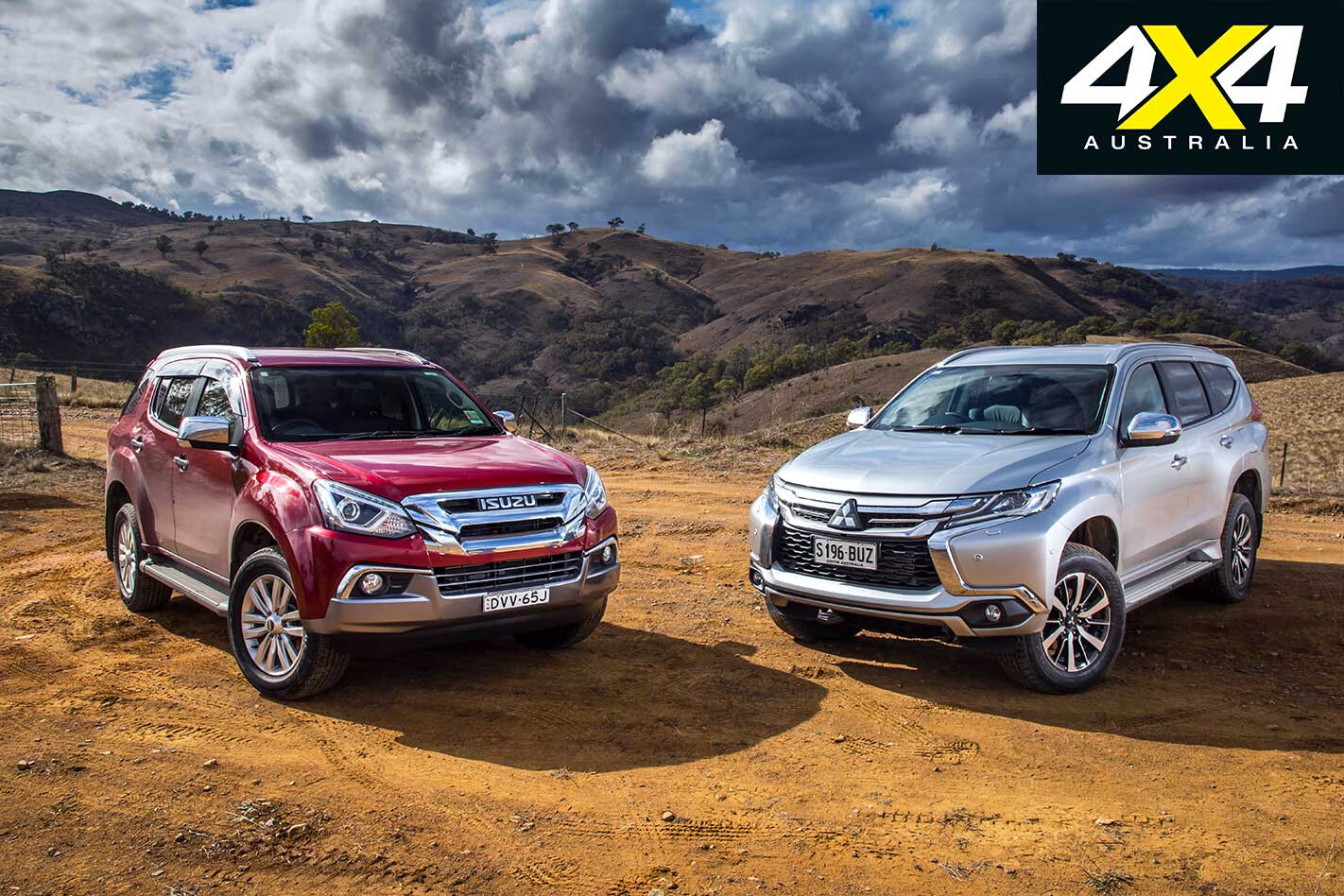
IF YOU’RE one of the few buyers today who prefers a manual rather than an automatic there’s only one choice, as only the MU-X is available as a manual, and then only in one of the three-equipment grades: the mid-spec LS-U.
After that, things become more complicated but still simple in a way. If interior space is your priority then it’s also the MU-X, as it’s a notably bigger wagon in all three rows of seats. Better for tall people up front, far more comfortable for three in the second row and it has a third row that can actually seat adults rather than just smaller children.
Conversely, if you prefer extra luggage space to third-row seats, or you simply don’t need seven seats, then the Pajero Sport is the only choice as all MU-Xs are seven-seaters.

If driving enjoyment is your priority then the Pajero Sport is better choice. It feels smaller and more agile than the MU-X, and the engine is quieter, smoother and generally more responsive thanks to the shorter final drive gearing and the relatively close ratios of the eight-speed automatic. There’s also the undeniable safety and functionality benefit of full-time 4×4 for all-road, all-weather driving.
The MU-X counters this with a more relaxed touring feel thanks to the taller gearing and the fact the engine doesn’t need as many revs as the Pajero Sport to get the same job done.
If off-road ability is your utmost priority then you’re probably looking in the wrong spot, as the Fortuner, Trailblazer and Everest are all better off-road. That’s not to say the MU-X and the Pajero Sport aren’t up to recreational off-roading, just that others are better straight off the showroom floor.
| u00a0 | Mitsubishi Pajero Sport Exceed | Isuzu MU-X LS-T |
| Engine | 2.4 litre 4-cyl turbo diesel | 3.0-litre 4-cyl turbo diesel |
| Power | 133kW @ 3500rpm | 130kW @ 3600rpm |
| Torque | 430Nm @ 2500rpm | 430Nm @ 2000u20132200rpm |
| Gearbox | Eight-speed automatic | Six-speed automatic |
| 4×4 System | Dual-range full-time (+2WD) | Dual-range part-time |
| Crawl Ratio | 45.9:1 | 33.3:1 |
| Tyre Spec | 265/60R18 110H | 255/60R18 108S |
| Kerb Weight | 2105kg | 2157kg |
| GVM | 2710kg | 2750kg |
| Payload | 605kg | 593kg |
| Towing Capacity | 3100kg | 3000kg |
| Towball Download | 310kg | 300kg |
| Gross Vehicle Mass | 5400kg | 5750kg |
| Departure angle | 24.2u02da | 21.1u02da |
| Rampover angle | 23.1u02da | 19.5u02da |
| Approach angle | 30u02da | 24u02da |
| Wading Depth | 700mm | 600mm |
| Ground Clearance | 218mm | 230mm |
| Fuel Capacity | 68 litres | 76 litres |
| ADR Fuel Claim | 8.0L/100km | 7.9L/100km |
| Test Fuel Use | 11.4L/100km | 11.5L/100km |
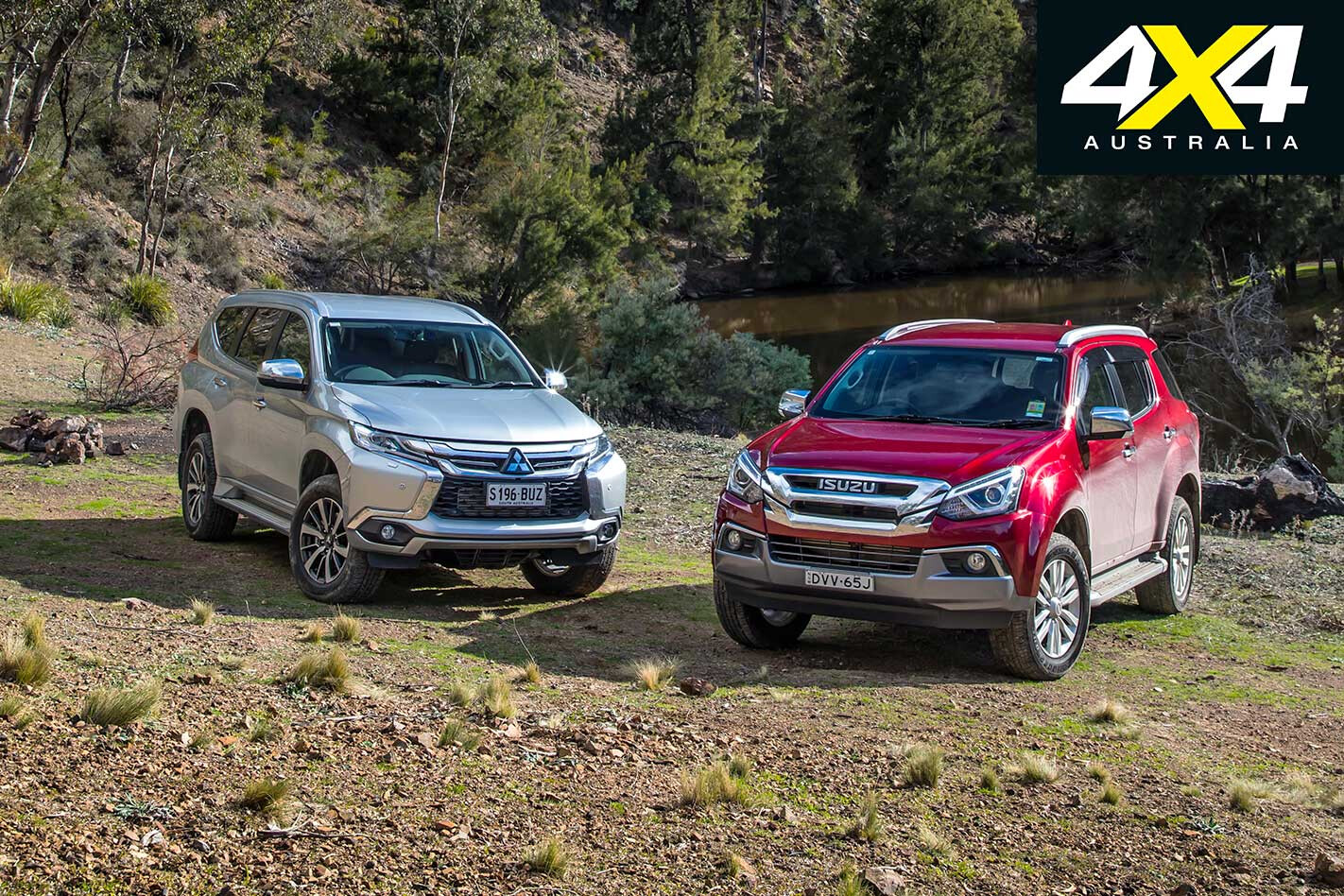
| Pajero Sport Prices* | Isuzu MU-X 4×4 Prices* |
| GLX (five seat): $45,000 | LS-M (auto): $50,200 |
| GLS (five seat): $48,500 | LS-U (manual): $50,400 |
| GLS (seven seat): $49,500 | LS-U (auto): $52,500 |
| Exceed (seven seat): $53,650 | LS-T (auto): $56,200 |
*Does not include on-road costs

